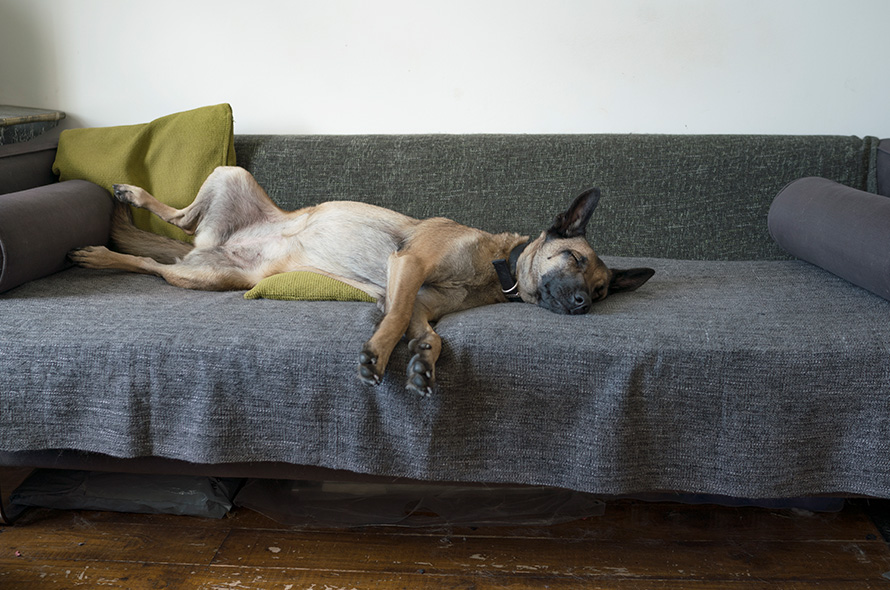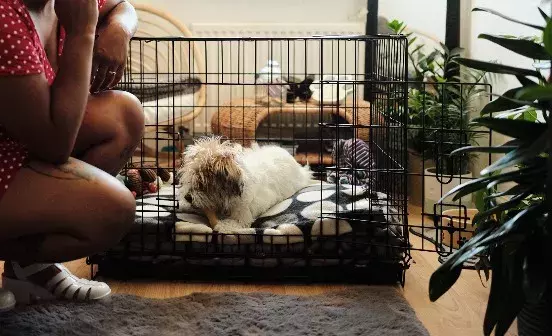Like all animals, a startle reflex is a dog’s brain and body’s way of helping protect them from potential danger. Sleep startle is also sometimes known as sleep aggression and occurs when a dog is woken up suddenly or unexpectedly. If a dog has been woken up by their brain telling them they’re in danger, it’s understandable that they may react in a fearful and potentially negative way.

This sleep startle reaction can affect dogs of any age, size or breed. It is often seen in dogs who haven’t lived around many people, or who haven’t been properly socialised during their early development. This is why it’s very common in ex-racing greyhounds who have come from professional kennel environments, and also former street dogs and dogs who have come from puppy farms.
Sleep startle in ex-racing greyhounds
A day in the life of a racing greyhound usually involves the majority of the day resting, often in a kennel, followed by short bursts of exercise. This means that they are used to long periods of undisturbed sleep. For this reason, some greyhounds from racing backgrounds can take time to adjust to a busier home life with more distractions and potential interruptions. Many greyhounds sleep with their eyes partially open, so it can appear like they are awake and aware when they are in fact, fast asleep and it’s this deep sleep which they should ideally not be disturbed from.
Sleep startle in puppy farm dogs and street dogs
Many dogs from puppy farms or who have lived on the streets will have never lived in a home environment. They probably won’t have had much contact with humans, and for most, any contact they’ve experienced is likely to have been negative. Because of this, dogs from these situations are unlikely to be immediately comfortable sharing a relatively small space, like a house or flat, with people. This huge adjustment is likely to mean they experience lots of stress when settling into a new home. The settling in period may take much longer than it would with pet dogs from more conventional backgrounds, and progress is likely to be much slower so lots of patience is needed. If a dog is feeling very stressed, it’s understandable that they might be more likely to startle if they’re approached when they’re sleeping and therefore, at least in their eyes, more vulnerable.
Sleep startle in pet dogs
Any dog can experience sleep startle, and it can often be a symptom of them feeling stressed, or if they’re not used to being around people. For example, the first few weeks settling into a new home can be quite stressful for any dog. Your dog is adjusting to new people, new environments and new routines, meaning that they have a lot to process and may experience some stress and anxiety during this time. All of these factors can make sleep startle more likely as they settle in.
How to stop sleep startle
While it may not be possible to stop sleep startle entirely, new owners can take steps to prevent their dog being put in the position where they might be startled:
- Give your dog their own bed in a quiet location, away from those areas people pass through regularly like a busy kitchen, near sofas in family spaces, or in hallways. If you have one, a spare room which isn’t always in use can be a great space for your dog to retreat to.
- It can be useful to introduce your dog to a crate, which can act as their own safe space to take themselves off to for a rest. It also creates a physical barrier around the dog whilst they sleep, which will help keep any children and other pets safe too. You can find out more about this in our crate training advice.
- All members of the family should avoid touching or approaching the dog when they are sleeping. If someone has to interact with the dog, they should begin talking to them from a distance and call the dog over to them once they’ve woken up
- Only approach your dog if you’re sure they are definitely awake and that they are aware of your presence. If not, then let sleeping dogs lie.
Download this guidance as a handy advice sheet and use it to train regularly:



